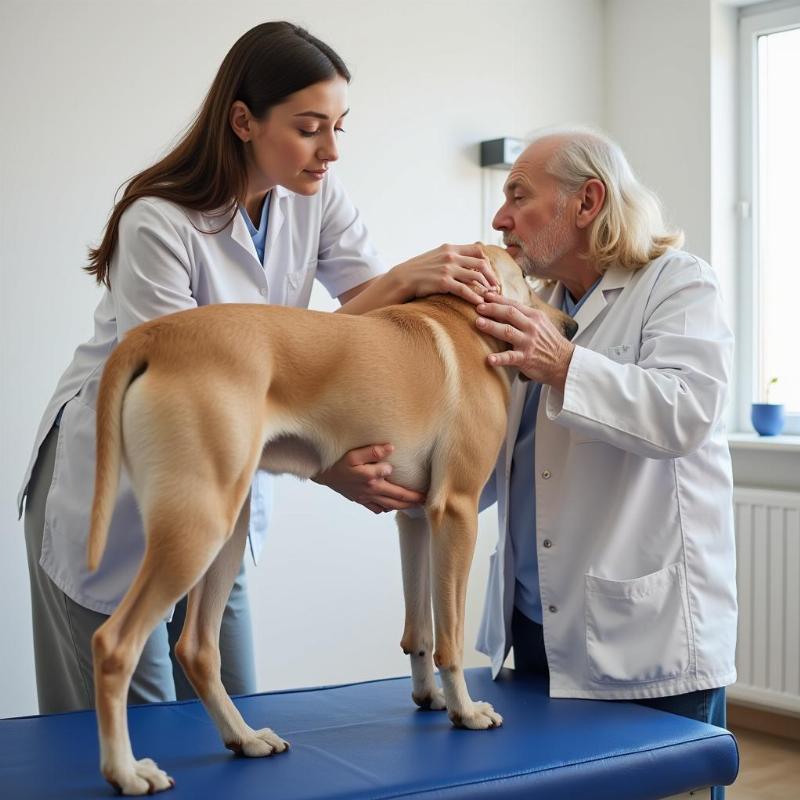When your beloved 14-year-old canine companion starts experiencing weakness in their back legs, it can be a worrying time for any pet owner. This is a common issue in senior dogs, and understanding the potential causes and available treatments is crucial for providing the best possible care. This article will guide you through the potential reasons why your 14 year old dog’s back legs are giving out, offering practical advice, and highlighting the importance of consulting a veterinarian for proper diagnosis and treatment.
Many factors can contribute to hind leg weakness in older dogs, ranging from arthritis to more serious neurological conditions. Identifying the underlying cause is the first step towards providing effective support and pain management. Let’s explore some of the most common reasons and how they can impact your furry friend.
Understanding Why Your 14-Year-Old Dog’s Back Legs Are Giving Out
Several conditions can contribute to hind leg weakness in older dogs. One of the most prevalent is arthritis, a degenerative joint disease that can cause pain, stiffness, and reduced mobility. As dogs age, the cartilage cushioning their joints wears down, leading to inflammation and discomfort. This is especially common in larger breeds and dogs with a history of joint injuries.
Another potential cause is hip dysplasia, a genetic condition where the hip joint doesn’t develop properly. While often diagnosed in younger dogs, the long-term effects of hip dysplasia can manifest as hind leg weakness in senior years. Intervertebral disc disease (IVDD), a condition affecting the spinal discs, can also cause weakness or even paralysis in the hind legs. This is particularly common in certain breeds like Dachshunds and Beagles.
Degenerative myelopathy (DM), a progressive neurological disease, can also lead to hind leg weakness and eventually paralysis. While there’s no cure for DM, supportive care can help improve your dog’s quality of life. Finally, certain tumors or masses in the spinal cord or surrounding areas can press on nerves, resulting in weakness in the hind legs.
Diagnosing and Treating Hind Leg Weakness in Senior Dogs
A comprehensive veterinary examination is essential to determine the underlying cause of your dog’s hind leg weakness. Your vet will likely perform a physical exam, neurological assessment, and may recommend blood tests, X-rays, or other imaging studies to reach a diagnosis. Once the cause is identified, a tailored treatment plan can be developed.
Treatment options vary depending on the specific condition. For arthritis, pain management medications, joint supplements, and physical therapy can help alleviate discomfort and improve mobility. In cases of hip dysplasia, surgery may be an option, while IVDD treatment can range from conservative management with pain medication and rest to surgery in severe cases.
 Veterinary exam for a senior dog
Veterinary exam for a senior dog
Supportive Care for Your Senior Dog
Regardless of the underlying cause, providing supportive care at home can significantly enhance your senior dog’s comfort and quality of life. This includes providing a comfortable and supportive bedding, using ramps or steps to help them navigate stairs or furniture, and maintaining a healthy weight to reduce stress on their joints. Regular, gentle exercise is also important for maintaining muscle strength and flexibility, but it’s crucial to avoid overexertion.
Consider incorporating assistive devices like harnesses or slings to help support your dog’s mobility, especially during walks or when navigating slippery surfaces. Providing a stimulating environment with engaging toys and activities can also help keep your senior dog mentally sharp and prevent boredom.
Conclusion
Witnessing your 14-year-old dog’s back legs giving out can be distressing, but with proper diagnosis and treatment, you can help improve their comfort and quality of life. Consulting a veterinarian is crucial for identifying the underlying cause and developing a tailored treatment plan. By providing supportive care at home and working closely with your vet, you can help your beloved companion enjoy their senior years to the fullest. Remember that aging is a natural process, and providing your senior dog with love, support, and proper care can make all the difference.
FAQ
- What are the first signs of hind leg weakness in dogs? Early signs can include difficulty standing up, swaying gait, knuckling of the paws, and reluctance to climb stairs or jump.
- Is hind leg weakness always a sign of a serious problem? Not necessarily, but it’s always best to consult a vet to rule out any underlying medical conditions.
- Can diet play a role in hind leg weakness? Maintaining a healthy weight is crucial for reducing stress on joints. Obesity can exacerbate existing conditions and contribute to mobility issues.
- How can I make my home more accessible for my senior dog with hind leg weakness? Consider using ramps, steps, non-slip rugs, and raised food and water bowls to make it easier for your dog to navigate.
- What are some exercises I can do with my senior dog to improve their hind leg strength? Consult your vet about appropriate exercises, as some exercises may be harmful depending on the underlying cause of the weakness. Short, gentle walks and controlled leash walks in water are often recommended.
- Are there any supplements that can help with hind leg weakness? Your vet may recommend joint supplements containing glucosamine and chondroitin to support joint health.
- How can I tell if my dog is in pain? Signs of pain can include changes in behavior, such as whining, restlessness, panting, decreased appetite, and reluctance to move.
Beautdogs.us is your premier resource for comprehensive dog care information and breed-specific advice in the USA. We cater to both novice and experienced dog owners, providing expert guidance on all aspects of dog ownership, from health and nutrition to training and grooming. For personalized advice and assistance, contact our expert team at [email protected] or call us at +1 501-555-7529. Beautdogs.us – your trusted partner in providing the best care for your canine companion.